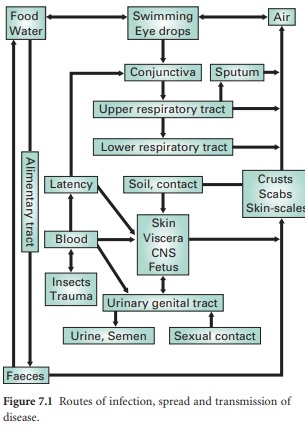Recovery From Infection: Exit of Microorganisms
| Home | | Pharmaceutical Microbiology | | Pharmaceutical Microbiology |Chapter: Pharmaceutical Microbiology : Principles Of Microbial Pathogenicity And Epidemiology
The primary requirement for recovery is that multiplication of the infective agent is brought under control, so that it ceases to spread around the body and that the damaging consequences of its presence are arrested and repaired. Such control is brought about by the combined functions of the phagocytic, immune and complement systems.
RECOVERY FROM INFECTION: EXIT OF MICROORGANISMS
The primary requirement
for recovery is that multiplication of the infective agent is brought under
control, so that it ceases to spread around the body and that the damaging
consequences of its presence are arrested and repaired. Such control is brought
about by the combined functions of the phagocytic, immune and complement systems.
A successful pathogen will not seriously debilitate its host; rather, the
continued existence of the host must be ensured in order to maximize the
dissemination of the pathogen within the host population. From the microorganism’s
perspective the ideal situation is where it can persist permanently within the
host and be constantly released to the environment. Although this is the case
for a number of virus infections (chickenpox, herpes) and for some bacterial
ones, it is not common. Generally, recovery from infection is accompanied by
complete destruction of the organism and restoration of a sterile tissue.
Alternatively, the organism might return to a commensal relationship with the
host on the epithelial and skin surface.

Where the infective
agent is an obligate pathogen, a means must exist for it to infect other
individuals before its eradication from the host organism. The route of exit is
commonly related to the original portal of entry (Figure 7.1). Thus, pathogens
of the intestinal tract are liberated in the faeces and might easily
contaminate food and drinking water. Infective agents of the respiratory tract
might be exhaled during coughing, sneezing or talking, survive in the
associated water droplets, and infect nearby individuals through inhalation.
Infective agents transmitted by insect and animal vectors may be spread through
those same vectors, the insects/animals having been themselves infected by the
diseased host. For some ‘fragile’ organisms (e.g. N. gonorrhoeae, T. pallidum), direct contact transmission is the
only means of spread between
individual hosts. In these cases, intimate contact between epithelial
membranes, such as occurs during sexual contact, is required for transfer to
occur. For opportunist pathogens, such as those associated with wound
infections, transfer is less important because the pathogenic role is minor.
Rather, the natural habitat of the organism serves as a constant reservoir for
infection.
Related Topics
